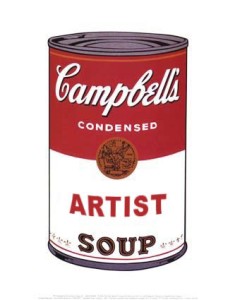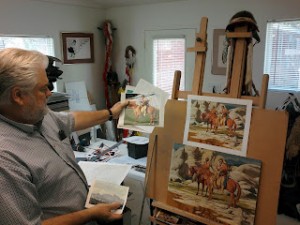Hey Artist, what does your BRAND look like?

Branding: The word ARTIST should be curved a bit shouldn’t it? It makes the can look flat.
Along with change, comes opportunity for artists
I hadn’t really developed brand for myself like I should have. I’ve been a freelance illustrator for almost 25 years and for the first 20 or so, it was business as usual. In the last five to seven years I’ve seen more changes in our industry than ever before. In some ways I must confess that if given the choice to see big changes or keep business as usual I would have ignorantly chosen the latter. Change isn’t fun. Change can be hard, change is usually painful. Change is scary because not knowing feels insecure and most of us crave security. But the reality is that change is on the menu to stay – so our choices are to dine or leave the restaurant and starve.
Being your own boss can be tough, “I hate my boss?”
In the past you were odd if you called yourself a freelancer. To most of the “normal” 9-5 crowd a freelancer was synonymous with freeloader or at best someone living on the fringe. Over time freelancers have become more mainstream. Most freelancers (myself included) own their job. In other words, they get an assignment from a company and then through their skills, crafts, or abilities satisfy that assignment. If they aren’t working they usually aren’t earning so while they have more freedom they still have to work to earn. And often, they/we work longer and harder.
Branding, A new job description for Artists
Now we’re seeing a whole new job description – The artist as “The Product”. Greg Spalenka a world renowned illustrator calls it “Artist as Brand”. In the past and present artist relied on companies to function as the liaison between them and the consumer. For gallery artists it was the gallery. For book illustrators – the publisher. For video game artists – the studio. These entities provide big money to produce and market products using art – the kind of money few artists could generate or commit to themselves. The artist’s risk is time – the companies risk is money. A symbiotic relationship that was virtually the only way – until now.
Artists now have a direct line to the consumer
Don’t get me wrong – I’m not saying that the days of these entities are over by any means but their roles are changing very quickly. The internet has in many ways leveled the playing field. Artists now have a direct line to the consumers for the products they create. “Never before in the history of the world have artists had the opportunity to reach their audiences so efficiently.” ~Wayne Andreason If you’re a fine artist you can develop a following through a website, social networking, blogging, emailing, etc. And don’t forget Pinterest. The same is true for children’s book illustrators, Picture book artists, graphic novel and comic artists, as well as art educators and so on. You say you want to produce your own video game? What’s stopping you? Many iphone games are now being produced by solo tech savvy artists or artists teamed up with a tech person. A simple upload to itunes and if the game is good they could start raking it in. “Were going to need a bigger rake!”
Nobody will hire me is no longer a valid excuse
The idea is that you can no longer use “nobody will hire me” as an excuse not to produce your own products. Many companies will go out of business in the near future. Many will adapt and thrive. For me I’m looking at each new request for my services in a different light. I’m trying to balance my freelance assignment time with time spent on producing my own projects.
So Write and Illustrate the children’s books
I’ve realized that even though I’ve been illustrating children’s books for over a decade and sold over 750,000 books (all combined) a very small percentage of my audience associates Will Terry with the books I’ve illustrated. This is a huge problem! We usually buy name brand products because people associate the brand with quality. I need to be constantly working on the Will Terry brand and for me one of the easiest ways to do that is to also start to write some of the books I illustrate. The reality is that it’s an authors world and illustrators really take a back seat in many ways. As I see it an illustrator can complain or become an author. Or take a backseat.
Take control of your own branding with technology
Last year as I was getting my brain around the changes I was seeing in art related industries I became frightened and depressed. The insecurity was really getting to me. Now that I’ve started to take control of my own branding I’m finding the future exciting and I’m always thinking of new ways to take advantage of the technology that has fallen in our laps.
Change is coming and it will keep coming. Go with it. Create your brand. Use the technology that is so readily available. Promote yourself. If needs be, start writing.


